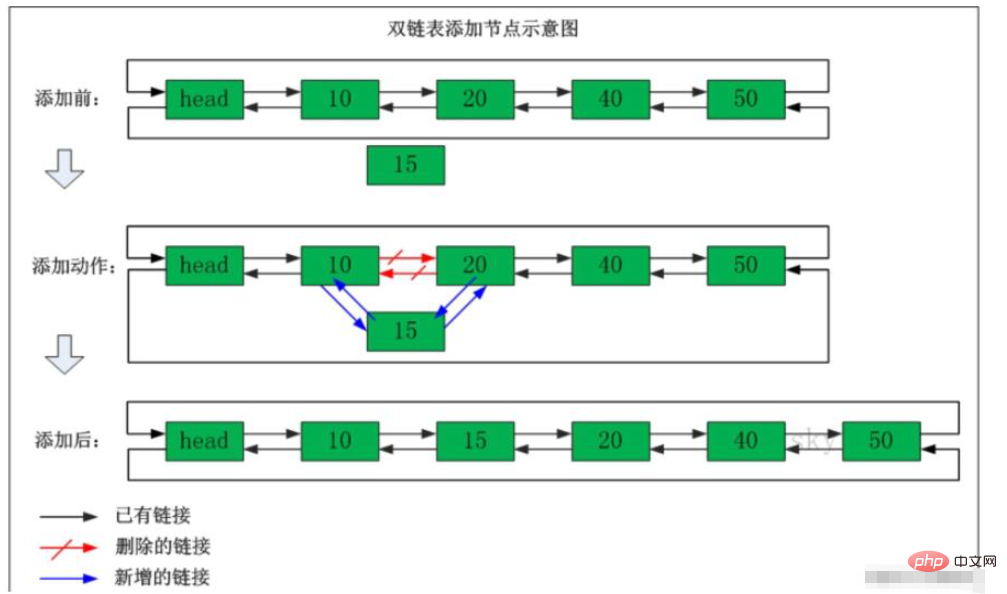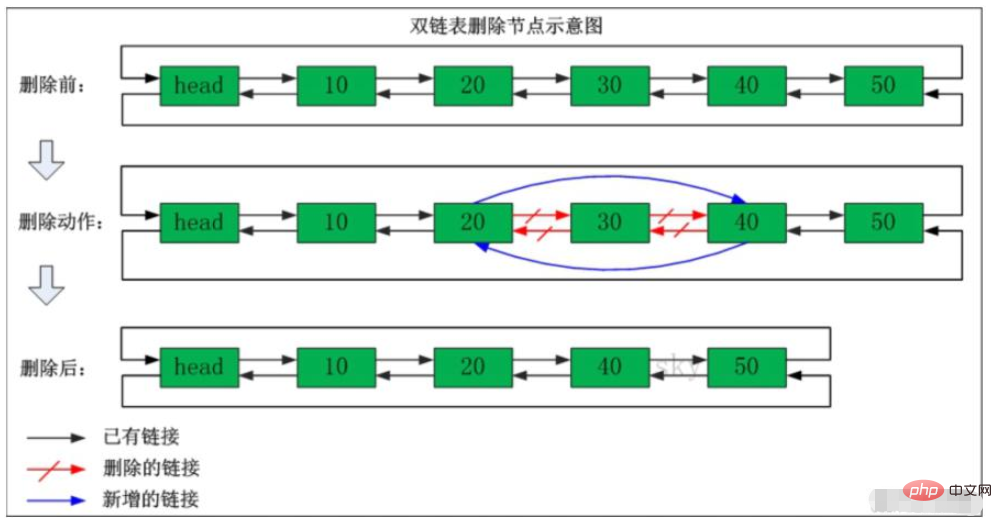How to implement a two-way linked list using java code
1. Introduction to doubly linked lists
1. Defects of singly linked lists
Singly linked lists can only access data elements in the linked list starting from the head node. If reverse order is required, Accessing data elements in a singly linked list would be extremely inefficient.
2. The structure of a doubly linked list
A doubly linked list is a type of linked list, consisting of nodes. Each data node has two pointers, pointing to Direct successors and direct predecessors.

3. Basic structure of doubly linked list class
class HeroNode2 {
//编号
public int no;
//名称
public String name;
//昵称
public String nickName;
//下个节点编码
public HeroNode2 next;
//上一个节点
public HeroNode2 pre;
public HeroNode2(int no, String name, String nickName) {
this.no = no;
this.name = name;
this.nickName = nickName;
}
public HeroNode2(int no, String name) {
this.no = no;
this.name = name;
}
@Override
public String toString() {
return "HeroNode{" +
"no=" + no +
", name='" + name + '\'' +
", nickName='" + nickName + '\'' +
'}';
}
}2. Operation of doubly linked list
1. Insertion operation of doubly linked list
 ##
##
//添加节点到单向链表
//1. 找到当前链表的最后节点
//2. 将最后这个节点的next指定新节点
public void add(HeroNode2 heroNode) {
//因为head节点不能动,所以需要一个辅助变量temp
HeroNode2 temp = head;
while (true) {
//根据是否有下个节点判断 是否到了链表动最后
if (temp.next == null) {
break;
}
//如果没有找到最后 temp后移
temp = temp.next;
}
//当退出循环时,temp就指向了链表的最后位置
//当最后这个节点的next 指向新的节点
//新节点的上一个节点指向temp
temp.next = heroNode;
heroNode.pre = temp;
}2. Deletion operation of doubly linked list

/**
* 根据编号删除节点
* 双向链表找到对应的节点直接删除
* @param no 节点编号
*/
public void deleteByNo(int no) {
//判断是否链表为空
if (head.next == null) {
System.out.println("链表为空");
return;
}
HeroNode2 temp = head;
//设置标识
boolean flag = false;
while (true) {
//已经遍历到链表尾
if (temp == null) {
break;
}
//找到修改节点的上一个节点
if (temp.no == no) {
flag = true;
break;
}
temp = temp.next;
}
//找到对应的节点
if (flag) {
//找到要删除节点的上一个节点 将删除节点的下一个节点 绑定为中间变量的下一个节点
temp.pre.next=temp.next;
if (temp.next!=null){
temp.next.pre=temp.pre;
}
} else {
System.out.println("没有对应的节点无法删除");
}
}
}The above is the detailed content of How to implement a two-way linked list using java code. For more information, please follow other related articles on the PHP Chinese website!

Hot AI Tools

Undresser.AI Undress
AI-powered app for creating realistic nude photos

AI Clothes Remover
Online AI tool for removing clothes from photos.

Undress AI Tool
Undress images for free

Clothoff.io
AI clothes remover

AI Hentai Generator
Generate AI Hentai for free.

Hot Article

Hot Tools

Notepad++7.3.1
Easy-to-use and free code editor

SublimeText3 Chinese version
Chinese version, very easy to use

Zend Studio 13.0.1
Powerful PHP integrated development environment

Dreamweaver CS6
Visual web development tools

SublimeText3 Mac version
God-level code editing software (SublimeText3)

Hot Topics
 Square Root in Java
Aug 30, 2024 pm 04:26 PM
Square Root in Java
Aug 30, 2024 pm 04:26 PM
Guide to Square Root in Java. Here we discuss how Square Root works in Java with example and its code implementation respectively.
 Perfect Number in Java
Aug 30, 2024 pm 04:28 PM
Perfect Number in Java
Aug 30, 2024 pm 04:28 PM
Guide to Perfect Number in Java. Here we discuss the Definition, How to check Perfect number in Java?, examples with code implementation.
 Random Number Generator in Java
Aug 30, 2024 pm 04:27 PM
Random Number Generator in Java
Aug 30, 2024 pm 04:27 PM
Guide to Random Number Generator in Java. Here we discuss Functions in Java with examples and two different Generators with ther examples.
 Armstrong Number in Java
Aug 30, 2024 pm 04:26 PM
Armstrong Number in Java
Aug 30, 2024 pm 04:26 PM
Guide to the Armstrong Number in Java. Here we discuss an introduction to Armstrong's number in java along with some of the code.
 Weka in Java
Aug 30, 2024 pm 04:28 PM
Weka in Java
Aug 30, 2024 pm 04:28 PM
Guide to Weka in Java. Here we discuss the Introduction, how to use weka java, the type of platform, and advantages with examples.
 Smith Number in Java
Aug 30, 2024 pm 04:28 PM
Smith Number in Java
Aug 30, 2024 pm 04:28 PM
Guide to Smith Number in Java. Here we discuss the Definition, How to check smith number in Java? example with code implementation.
 Java Spring Interview Questions
Aug 30, 2024 pm 04:29 PM
Java Spring Interview Questions
Aug 30, 2024 pm 04:29 PM
In this article, we have kept the most asked Java Spring Interview Questions with their detailed answers. So that you can crack the interview.
 Break or return from Java 8 stream forEach?
Feb 07, 2025 pm 12:09 PM
Break or return from Java 8 stream forEach?
Feb 07, 2025 pm 12:09 PM
Java 8 introduces the Stream API, providing a powerful and expressive way to process data collections. However, a common question when using Stream is: How to break or return from a forEach operation? Traditional loops allow for early interruption or return, but Stream's forEach method does not directly support this method. This article will explain the reasons and explore alternative methods for implementing premature termination in Stream processing systems. Further reading: Java Stream API improvements Understand Stream forEach The forEach method is a terminal operation that performs one operation on each element in the Stream. Its design intention is






